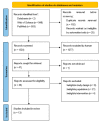School-Based Exercise Programs for Promoting Cardiorespiratory Fitness in Overweight and Obese Children Aged 6 to 10
- PMID: 36138633
- PMCID: PMC9498030
- DOI: 10.3390/children9091323
School-Based Exercise Programs for Promoting Cardiorespiratory Fitness in Overweight and Obese Children Aged 6 to 10
Abstract
The aim of this study was to conduct a systematic review of the school-based exercise programs for promoting cardiorespiratory fitness in overweight and obese children aged 6 to 10. Electronic databases (Web of Science and PubMed) were used as searching tools for collecting adequate studies published in the past 20 years. A total of 13 studies met the criteria for inclusion in this review, with a total of 2810 participants, both male and female. According to the results of this systematic review, overweight and obese children aged 6 to 10 who underwent certain interventions had their CRF improved. Furthermore, evidence suggested that interventions carried out during a longer period of time suggested led to greater improvement of cardiorespiratory fitness than a shorter one, but the level of cardiorespiratory fitness gradually decreases after the intervention.
Keywords: children; health; monitoring and promoting; motor competence; obesity; physical activity; physical fitness; sedentary behavior; sport; well-being.
Conflict of interest statement
The authors declare no conflict of interest.
References
-
- Veijalainen A., Tompuri T., Haapala E.A., Viitasalo A., Lintu N., Väistö J., Laitinen T., Lindi V., Lakka T.A. Associations of cardiorespiratory fitness, physical activity, and adiposity with arterial stiffness in children. Scand. J. Med. Sci. Sport. 2016;26:943–950. doi: 10.1111/sms.12523. - DOI - PubMed
-
- Ortega F.B., Ruiz J.R., Castillo M.J., Moreno L.A., Urzanqui A., González-Gross M., Sjöström M., Gutiérrez A. Health-related physical fitness according to chronological and biological age in adolescents. The AVENA study. J. Sports Med. Phys. Fit. 2008;48:371–379. - PubMed
-
- Ruiz J.R., Cavero-Redondo I., Ortega F.B., Welk G.J., Andersen L.B., Martinez-Vizcaino V. Cardiorespiratory fitness cut points to avoid cardiovascular disease risk in children and adolescents; what level of fitness should raise a red flag? A systematic review and meta-analysis. Br. J. Sports Med. 2016;50:1451–1458. doi: 10.1136/bjsports-2015-095903. - DOI - PubMed
Publication types
LinkOut - more resources
Full Text Sources
Miscellaneous


